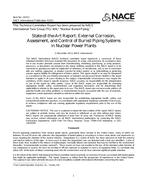Description
Recent operating experience from nuclear power plants, particularly those located in the United States, many of which are between 30 and 40 years old, indicates that degradation of buried piping is occurring in at least some plants and represents an issue requiring the attention of the nuclear industry. Degradation in a variety of forms has been observed on both the external and internal surfaces of the pipe. In most cases to date, the degradation was not detected until a leak was identified. Some of these leaks have resulted in the release of radioisotopes (normally tritium) and materials that may be harmful to the environment (hereafter, 'environmentally sensitive material'). These events (a) have not resulted in the loss of the intended safety function of any component or system; (b) have not resulted in off-site exposure to radiation in excess of regulatory limits; (c) constitute only about 10% of the leaks of tritium containing water into the environment; and (d) have attracted significant public attention.
It is the intent of this NACE International technical committee report to provide an overview of issues associated with buried piping that might be applicable worldwide. This report, however, is written from the perspective of experiences in the United States. This approach was taken primarily because of a lack of publicly available international information concerning this topic.
This report addresses a subset of the operating experience described above. It includes only topics related to the external corrosion of buried piping, i.e., piping that is in direct contact with soil or concrete. It does not include topics related to internal corrosion of buried piping. Additionally, it does not include topics related to the corrosion of buried tanks, such as those in contact with soil, concrete, or underground piping and tanks, i.e., those enclosed in a vault or trench.
As with all NACE state-of-the-art reports, it is not the intent of this report to be a complete treatise on the subject of degradation, corrosion prevention, or corrosion mitigation of buried piping. Rather, it is the intent of this report to identify issues for corrosion professionals to consider when addressing degradation of buried piping in nuclear power plants. The report introduces subjects and identifies applicable reference material on the subject. When a specific issue related to buried piping degradation is found to be unique to nuclear power plants, and when ample reference material is not available, this report provides additional text concerning the issue. The length of the sections of this report correlate with the uniqueness, not the importance, of the topic considered with respect to buried piping at nuclear power plants.
Product Details
- Published:
- 12/01/2013
- Number of Pages:
- 19
- File Size:
- 1 file , 440 KB
